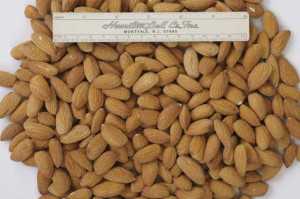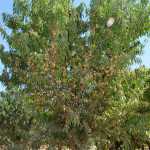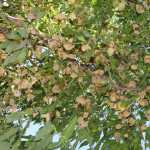Self-Compatible Almond Tree Released
Burchell Nursery has developed a new commercial almond tree that can be called a stand-alone variety. The Lone Star, the result of 11 years of painstaking crosses, is finally shining bright.

Lone Star produces attractive, light-colored kernels that look similar to Nonpareil or Sonora.
(Photo Credit: The Burchell Nursery)
Ron Boone, a Burchell field representative, says the quality of the nuts produced by Lone Star is excellent, and the kernel blanches well. “We showed it to handlers and they were very favorable,” he says. “They said it was just like Nonpareil so the grower should get a good price.”
The variety blooms early, about four days before Nonpareil, and it harvests about 7-10 days after. Some researchers think the production will go down in self-compatible trees as they age, Boone says, as they will essentially become less self-compatible. Because of that, Burchell is recommending a 90% Lone Star to 10% Nonpareil planting ratio. “In the almond business, we’re all about production,” he says, “so we just think it’s a prudent way to plant long term.”
Compatible With Others
Besides being self-compatible and pollinating Nonpareil, Lone Star also pollinates Avalon, Wood Colony, Price, Aldrich, and Monterey. In talking with growers, Boone says they value high returns, but also want a safety net. “If they have 100 acres, and all 100 acres blooms at once and a storm comes, they’re stuck,” he says. “They need to spread out risk as far as the weather is concerned.”

Lone Star, the new self-compatible almond variety from The Burchell Nursery, is a large, vigorous, somewhat upright tree.
(Photo credit: The Burchell Nursery)
Lone Star is also a large, vigorous tree which can provide advantages, says Boone. “There’s something to be said for vigor,” he says. “If you have a heavy crop load and you have high vigor you can still set a nice crop the following year.”
In addition, the nuts are not bunched together on Lone Star, as they tend to do on some almond varieties. “It’s not a ‘clustery’ type,” he says. “It distributes the crop load evenly which limits limb breakage.”
More To Come
Lone Star will be available on a limited basis in 2015, says Boone, and will be fully available in 2016. The variety was developed by Burchell’s own John Slaughter, who Boone says is the industry’s only in-house plant breeder. The first and only other self-compatible variety to be made commercially available, Dave Wilson Nursery’s Independence, was developed by Zaiger Genetics.

Lone Star doesn’t generally produce nuts in clusters. The crop load is spread throughout the tree.
(Photo credit: The Burchell Nursery)
Boone says Slaughter is keeping busy, and Lone Star is likely the first in a series of self-compatible almond varieties that will be introduced by Burchell, as a couple others may be unveiled in the next few years. “The harvest and bloom time would be different than Lone Star so you’d get some diversification,” he says. “We want to let the grower spread the risk.”









